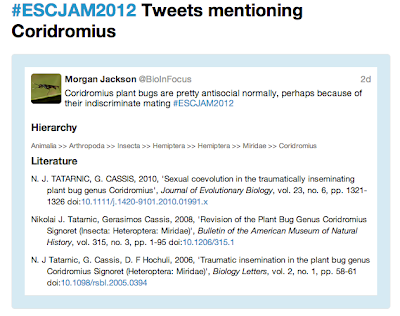Having been a remote Twitter participant in what from all accounts was a successful conference hosted by the Entomological Society of Canada and the Entomological Society of Alberta, I have the luxury of now stepping back with a nice glass of red wine and thinking more deeply about the experience and its implications on the health of science. Dezene Huber has also taken a breath after he participated in person and provided valuable Tweet streams of his own.
The Saturday prior to the conference, I had a "wouldn't be cool if" moment and put my fingers to action on a toy that could listen in on the Tweet streams being generated by conference goers as they prepared for the event, as they were in transit, as they sat in the audience, as they chatted over coffee, and as they celebrated their winnings during the banquet.
My roughshod little experiment was to encourage participants to include scientific names in their streams. After all, names are a very important part of how biology is communicated. I grabbed their Tweets in real-time, fed them into three web services, and stored the results in a relational database. Two of these web services were developed by me and Dmitry Mozzherin at the Marine Biological Laboratory under the NSF-funded Global Names project led by David Patterson. These gave me the tools necessary to answer the questions, "Is this a name?" and "Where is this name in a classification?" The other web service I used was one recently assembled by some brilliant developers at CrossRef that figured out a way to execute rapid searches against their massive database of citations in the primary literature, assembled off the backs of researchers and publishers.
So, while "Ento-Tweeps" tapped a name, I immediately caught it, placed it in a hierarchy, and threw it to CrossRef. Within a split second after a Tweet appeared, I had links to the primary literature and I had some context. These were often amazingly accurate. Here's one that the prolific Morgan Jackson tweeted during Nikolai Tatarnic's paper entitled, "Sexual mimicry and paragenital divergence between sympatric species of traumatically inseminating plant bug":
Now that's useful!
However...
There were occasions where this wasn't so useful. These were examples of what some have called, "Information Overload". But that's a misnomer. We're beginning to understand what this really is. A better term for this (if one were to become dependent and fixated on streams like this) is "Information Overconsumption".
So, how do we responsibly integrate the power of social media in scientific conferences?
First, draft a light-hearted code of ethics - the same as we've become accustomed to with mobile phones at such events. Turn off the beeps and squawks! Turn off the unnecessary keypress chirps.
Second, as tempting as it may be, DO NOT COMMERCIALIZE THIS! The corporate sector has already found its way into the conference arena, the last pure outlet for the exchange of science. A social media outlet could be a new channel for communication that will be instantly switched off if it were behind a paywall.
Last, treat the messages not as news, but as products. Though the messages are instant, much like a stream of news, they are written by you, the one who has spent years honing your skills and learning your science.
My only hope is that "toys" like mine and the web services upon which they depend improve with time. They MUST help sell your products in a way that does not lead to Information Overconsumption and they MUST add value to the messages you wish to convey. How? That's up to you.

